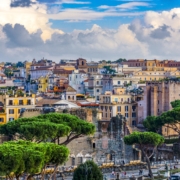The Doge’s Palace (Palazzo Ducale) is one of the main attractions of Venice, located in its heart – Piazza San Marco. Read about other landmarks of the square in our separate article. Today, we’ll explore what awaits you inside if you buy a ticket, the historical significance of the palace, and whether a guided tour is worth considering.
How Much Does a Ticket to the Doge’s Palace in Venice Cost?
A ticket costs 30 euros at the ticket office. The downside: expect to wait in line for about an hour. If you’d rather not waste time and energy, buy a skip-the-line ticket here – same 30 euros, but without the wait.
On the official website, tickets cost 25 euros, but there’s a catch: you must book at least 30 days in advance. If you’re out of time, here’s a last-minute ticket option.
Your ticket grants access to several locations: Correr Museum, the National Archaeological Museum, and the Biblioteca Nazionale Marciana.
Doge’s Palace Opening Hours
The palace is open daily, year-round, except on public holidays. The schedule is as follows:
- April 1 – October 31: 09:00–19:00 (last entry at 18:00)
- November 1 – March 31: 09:00–18:00 (last entry at 17:00)
» READ MORE – Venice in 1 Day: Itinerary
When Was the Doge’s Palace Built?
Who Was the Palace Built For and Why?
The palace was constructed as the seat of the Doge, the ruler of the Republic of Venice. Over time, 120 Doges governed from here until the republic’s fall in 1797.
Besides housing the Doge, the palace also accommodated the government of the republic, the Supreme Court, the Secret Police, and the Chancellery.
History and Architectural Styles
The first iteration of the palace dates back to the 9th century, but nothing remains of that structure. Over the centuries, the Doge’s Palace burned down multiple times and was rebuilt.
- 12th–13th centuries: The palace was remodeled with Gothic elements
- 15th century: Underwent another major reconstruction, this time in Renaissance style
- 16th century: Two fires destroyed much of the artwork in the Great Council Hall, including pieces by Titian. After restoration, the authorities decided to return the palace to the Gothic style
The Palace Today
Today, the Palazzo Ducale is a major tourist attraction, generating revenue for the city. Every visitor comes to see its oppressive prison cells, the Doge’s quarters, and Renaissance masterpieces.
What to See in the Doge’s Palace
Doge’s Palace Prison
Prison cells in the palace were divided into two types:
- Pozzi («wells»): Dark, damp, and oppressive cells for common criminals
- Piombi («lead prison»): More comfortable cells for political prisoners
The famous Giacomo Casanova was held in one of the Piombi cells. Sentenced to five years, he escaped by literally scraping his way out with a piece of metal.
Bridge of Sighs
Built in 1602, the Bridge of Sighs connects the main prison building to the Lead Prison. The sighs were not from lovers but from prisoners being led to their fate.
Staircase of Giants
For centuries, the Doge’s coronation took place atop this grand staircase. Statues of Poseidon and Mars symbolize Venice’s commercial and political power, respectively. Between them stands a lion – the emblem of St. Mark, the city’s patron saint.
» READ MORE – San Marco Cathedral: Tickets, History, What to See
Armoury
The palace’s Armoury houses over 2,000 exhibits, including 15th- and 16th-century armor, swords, halberds, crossbows, and weapons seized from the Ottoman Empire.
Great Council Hall
This hall was the center of Venetian power, where the Council of the Republic debated financial and political matters and issued sentences to prisoners.
One of the room’s most striking features is Tintoretto’s «Paradise», the largest oil painting on canvas in history.
The Doge’s Chambers
The Doge and his family lived in the palace. Their quarters, located between the Golden Staircase and the apse of St. Mark’s Cathedral, remain preserved as they were from the 8th to the 18th century.
Golden Staircase
The Doge’s chambers occupied only one floor of the palace. To reach them, visitors must ascend the Golden Staircase, adorned with richly decorated vaults.
Torture Room
Another chilling feature of the palace is the torture chamber. Although Venice was known for its relatively mild forms of torture, one common method involved suspending prisoners by their tied arms. Unpleasant, but not nearly as cruel as the «Spanish boot» torture used in France.
» READ MORE – Venice Neighbourhoods: Where is the Best Place for a Tourist to Stay?
Tours of the Doge’s Palace in Venice
The best way to experience the Doge’s Palace is with a guide. A guided tour brings the palace’s history to life, offering a vivid picture of Venice during the Republic – far better than simply wandering around with Google.
We’ve selected some excellent tours from our partners – pick the one that suits you best:
- The «Secret Route of the Doge’s Palace» tour takes you through hidden rooms, prison cells, and the torture chamber. Conducted in English, lasting 3 hours, and includes entry to St. Mark’s Basilica. Book your spot here
- Prefer a more intimate experience? Opt for this private tour of the palace and basilica
- If you just need guidance inside, book a ticket with a guide who will help you navigate the Great Hall and prison cells. Click here
In Lieu of a Conclusion
If you stand facing the west wing, adjacent to St. Mark’s Cathedral, you’ll notice that all the columns are white, except for two pink ones. These were the spot where the Doge announced death sentences.
Executions and tortures have long faded into history, but the pink columns remain – whether as a tradition or a silent tribute to the past.
We wish you a fascinating visit to the Doge’s Palace!





 voyage10.com
voyage10.com 



 Bryan Brittos / Unsplash
Bryan Brittos / Unsplash  StockSnap / Pixabay
StockSnap / Pixabay Tjaard Krusch / Unsplash
Tjaard Krusch / Unsplash
Leave a Reply
Want to join the discussion?Feel free to contribute!